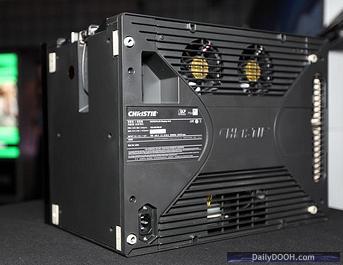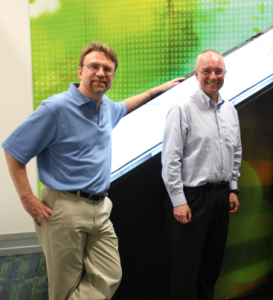Since the launch of Christie Digital’s MicroTiles a few weeks back a question we keep being asked is “What displays can you tile and why hasn’t the industry created shapes before?”
So what sorts of screen technology can actually be made into shapes and indeed what can be ’tiled’?

Adrian called this 'Bezelmania'
Of course traditional LCDs / PDPs can be butted (adjoined) together but the bezels (however small) usually end up being a problem and the screens themselves are simply placed next to each other – there is no joining / fixing or intelligence between them (outside of some controller unit or configuration that is subsequently told where they all are).
Also these sorts of installs typically require complex and often custom built mounting assemblies, especially for examples like this interesting Sony panel array installed last year in Terminal 5 of London’s Heathrow Airport.
And when these sorts of displays are ‘put up’, they usually stay ‘up’ – they are definitely designed to stay where they are!
So in terms of actual tiling: LEDs as previously mentioned are tiled, the old Cambridge based, Screen Technology iTrans system (now of course a much improved Litemax LiTile34) product, the Magink display system (reflective, digital ink style competitor to LED), Orion tiled plasma arrays, and a new system not yet officially launched (tentatively) called Spudnik are also tiled.
MicroTiles have a number of design features, both physical and electronic, that allows the process of installation, especially in different screen shapes, to be a whole lot easier than it’s been until now.

Rear view of MicroTile unit
The most obvious is the form factor – they are relatively small building blocks 16″ x 12″ (about 400 x 300mm) and 10″ (260mm) deep.
This means each tile unit is easily handled, and doesn’t need two people to lug each one about. They fit together and lock in place with precision, so there’s minimum mechanical adjustment required while physically building the screen display. And unless the display is a big one, there is no need for additional mounting assembly ironwork to support it.
The size of each unit is an intelligent compromise – too small and they would be laborious to assemble on a large scale, too large and each unit becomes awkward to handle and non-standard screen shapes look too blocky.
The connections are simple – mains power to each tile, and daisy chain the signal cable from one unit to the next – no complicated settings or switches to configure on each unit while building the screen.
Once you power it up, the ECU controller does the rest – it talks to each tile unit and discovers the whole layout of the screen array, and so tells each tile which bit of the video image to display. This means the video image fed in to the ECU is scaled correctly across the whole screen area with no manual configuration necessary, whatever the shape of the array.
A more subtle (but still important) function of the ECU is to measure the output of the LED light source in each unit and calibrate the whole array for brightness, contrast and colour balance conformity – again no manual configuration required. This has traditionally been a much more tricky task across large displays (even more so if TV production is involved – cameras tend to see things in a different way to us), usually requiring a skilled engineer and a fair bit of time.

MicroTile co-inventors, Mike Perkins & Bob Rushby
In fact to illustrate the point about installation simplicity, Bob Rushby, CTO, Christie Digital (and MicroTiles co-inventor) refers to his wife, Jane, in an article about the history of MicroTiles.
His goal was to make the product simple enough so that without detailed technical training, she (Jane) could assemble them into some type of screen, plug it in, switch it on, and without any further configuration it would display images on the screen correctly with proper colour and brightness balanced across the screen.
Rushby wanted tiled displays to ‘just’ work without needing experts to set them up.
Indeed, thinking of a retail situation, it would not be difficult to quickly tear down a working display and put it back up as a different shape in a new position, ready for the next new in-store retail or window merchandising promotion.
Now, you really wouldn’t have wanted to do that before on any sort of regular basis, would you?




Follow DailyDOOH